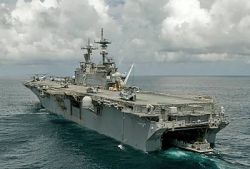SAN DIEGO, Sept. 17, 2010 — The presence of National Guard troops along the Southwest border has provided U.S. Customs and Border Protection agents with an additional resource to counter drug smuggling, human trafficking and other threats along the border, senior Guard officials said this week.
“With every place we’ve visited, our colleagues at Customs and Border Patrol couldn’t praise them enough with stepping up and really providing an incredible capability that gives them the operational flexibility they need, said Army Maj. Gen. Peter Aylward, special assistant to the chief of the National Guard Bureau.
Additional flexibility also gives border patrol agents a greater ability to focus on specific areas within their sectors.
“It helps us alleviate high-traffic areas,” said Mario Escalante, a Customs and Border Patrol supervisory agent. “More than anything else, they will be working as additional eyes and ears. They will be working in … [entry identification sites] giving not just situational awareness of what is going on, but also acting as a [deterrent].”
The deterrence factor readily can be seen in the number of arrests made by Customs and Border Patrol agents. In the Tucson sector, daily arrests have been on a steady decline, said U.S. Customs and Border Patrol officials, who attributed the drop in numbers to the Guard troops on duty in the area.
The decrease has been steady for the past few years, officials said, adding that Operation Jump Start, initiated in 2006, provided a much-needed boost.
Because of that, the mission along the border isn’t quite what some troops imagined it would be like.
“When I volunteered for this mission, I expected it to be actually mass amounts of people always crossing over,” said Army Spc. Joseph Syed of the Arizona National Guard. “I really didn’t know what to expect to see, but in my mind I expected to see people just hopping [over the border] and running.”
Still, Syed said, illegal activity along the border still remains constant, with smugglers searching for new ways to cross people and illicit substances across the border.
“We mostly see folks during the day,” he said. “We haven’t seen too many people at night. It started out with one or two scouts a day, and now we have more along the ridge. Now they are actually bringing groups with them.”
Aylward said those smuggling operations often fund larger enterprises, such asnarcoterrorism and transnational threats..
Many have compared the current rotation of Guard troops along the border to Operation Jump Start. The geographical areas may be the same, but that is where the similarity ends.
“This is really totally different than Operation Jump Start,” Aylward said. “It is another phase, another chapter to make sure we’re doing everything we can to maintain the sovereignty of our borders.”
One of the biggest differences is the ramp-up of troops. On average, Guardsmen will go through four weeks of additional training prior to working on the border. They began to arrive along the border in late August and early September, and, as of yesterday, slightly more than 1,200 Guardsmen were in training or already deployed to the border.
The additional time allowed the states to ensure that things ran smoothly, said Air Force Brig. Gen. Jose Salinas, commander of the Arizona joint task force, Operation Copper Cactus.
“With the ramp-up, it’s given us the time to train people, make sure our orders are in place, make sure we get our chain of command up to speed,” he said. “[The troops] feel like they’ve been properly prepared for the situations they might see.”
The training was based on scenarios that ranged from border crossers just needing water to encountering more aggressive, hostile groups.
“They are also getting training in a lot of the technology that we have,” Salinas said. “I feel very confident our troops are getting what they need to perform the mission properly.”
In all of these missions, Guard troops are strictly in support of the Customs and Border Patrol or Immigration and Customs Enforcement officials.
“We see something, and we call it in to Border Patrol,” Syed said. “They’ll go check it out.” This helps Customs and Border Patrol to better focus on specific security issues, he added.
“The augmentation that we’re providing gives them the operational flexibility so they can pool their resources and cover down on those vulnerabilities that have previously existed,” said Aylward, who added that the Guard is part of lessening those vulnerabilities, while the Customs and Border Patrol recruits and trains additional agents.
Aylward, who’d toured all four border states this week, said he has been impressed with what he has seen.
“The motivation, the professionalism and the attitude across the board has been superb,” he said. “It really makes you feel proud to be a part of the team, and it really has been a great experience to come out and visit with the leaders and the soldiers that are performing this mission.”
Source:
U.S. Department of Defense
Office of the Assistant Secretary of Defense (Public Affairs)

 von
von 

